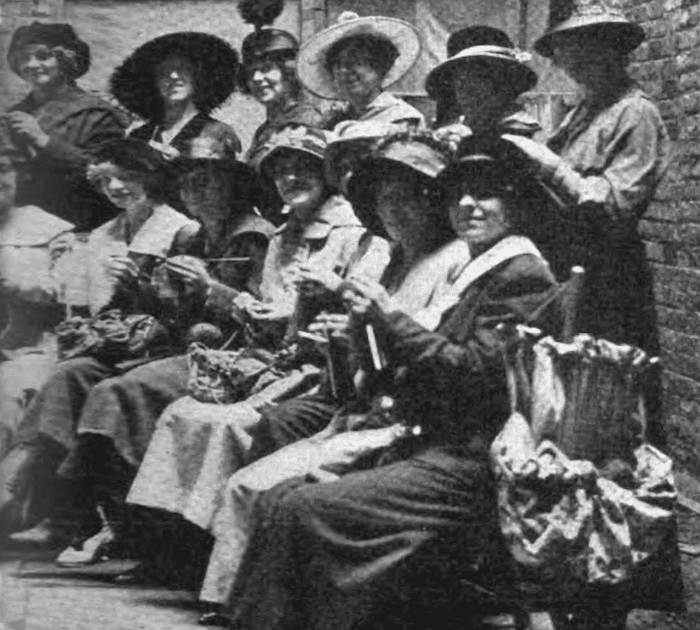27th Assembly Dist. (NY), The Woman Suffrage Party, detail of photo from The Woman Citizen, Oct. 6, 1917. These suffragists are knitting for the troops and showing their patriotism as they pursue their goal of gaining the right to vote.
Historical knitting circles are precursors of today’s craftivist movement
My community art project Knit Democracy Together is built around knitting circles. You might not expect these to be a setting for activism, but as contemporary craftivist Sarah Corbett teaches, there is power in gentle protest. The KDT gatherings relate back to historical knitting circles where women came together to knit for a social purpose.

Knitted building blocks made by knitting circle participants in Eve Jacobs-Carnahan’s Knit Democracy Together project.
Knitting’s role in American independence and anti-slavery movement
Leading up to the American Revolution, the colonists’ boycotted British textiles, so colonial women went to work making homespun clothing. The Daughters of Liberty held parties and competitive events where women would spin, knit, and weave as men patriotically cheered them on. During the Revolutionary War, women organized groups to knit stockings and deliver them to freezing soldiers who were notoriously under-supplied with warm clothes. Like today, women took matters into their own hands and provided solutions to problems where government leadership was lacking.
Knitting circles are place for conversation, and when the purpose of gathering is to enact reform, the conversation can further the movement. That’s what the Boston Female Anti-Slavery Society did in the mid-nineteenth century. Abolitionist societies knit fancy textiles, caps and shawls to sell at anti-slavery fairs to raise money for abolitionist groups. The 1840 annual fair abolitionist fair in Massachusetts was so large it had to be held in Faneuil Hall, Boston.
Poster from an anti-slavery bazaar in Weymouth, Mass., where handmade items such as knitted stockings were sold to raise money. Photo from Fifield Family Collection, Weymouth Public Library, Tufts Library (digital.commonwealth.org).
Suffragists used knitting to get attention
Today’s artists and craftivists use knitting as a symbolic tool. It carries connotations of femininity and domesticity. Rather than disparagement, that can be a statement of the value of women’s work. During World War I, the Red Cross encouraged women to do their patriotic duty by knitting bandages, helmet liners, hot water bottle covers, bed socks, and wash rags. Some suffragists took advantage of the enthusiasm around the war effort and used it to get attention for women’s rights.
The women of the New York City 27th Assembly District Woman Suffrage Party demonstrated their organizational skill by making 3560 items of clothing for sailors on the USS Missouri. The suffragist Helen Hill told a news reporter that these women could get the job done easily, since “these are the same women who helped get the signatures of more than 500,000 women of New York City who want to vote. Women who did not let the grass grow under their feet until they had performed that arduous task are not likely to stop at a little thing like knitting winter garments for 712 sailor boys.”Susan M. Strawn, Knitting America: A Glorious Heritage from Warm Socks to High Art (Voyageur Press 2011).

Knitting Ballet of the Hippodrome, NY suffragists knitting for sailors on the USS Missouri, 1917. Photo from Woman Citizen, Oct. 6, 1917.
The power of knitting circles
As The Woman Citizen, a publication of the National Women’s Suffrage Association reported on April 13, 1918, two hundred women marched on the New York State capitol in Albany with their knitting bags to protest unjust labor laws. New York women had recently obtained the right to vote, and the journal pointed out: “Behind the knitting bags were knitters, and behind the knitters were ballots. And this is why the legislators saw these women for the first time as real people.”
The Knit Democracy Together knitting circles are a craftivist update on historic knitting circles. As circle participants learn about election campaign finance reform, they make building blocks for a sculpture of a state capitol building. The blocks, constructed by many hands in many styles, symbolize our diverse community. When democracy works well, the members of the legislature represent the entire community. By assembling to knit, learning about reform measures, and discussing improvements, knitters can foster change.
Further reading:
The New England Historical Society has more about the women of the American Revolution here, and about the anti-slavery fairs organized by Maria Chapman here. For more reading about activist knitting history, see Tove Hermanson, “Knitting as Dissent: Female Resistance in America Since the Revolutionary War,” Textile Society of America Symposium Proceedings, Sept. 1, 2012.
For Sarah Corbett’s TED talk on quiet activism, see this video.


This is brilliant. Great idea. Thank you for the history (who knew) and the current activism.
Thanks, Nicky! I love discovering historical echoes in today’s world. It’s great to see how earlier generations were pathmakers too.